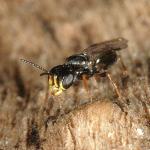Spilomena exspectata VALKEILA 1957
The small (2.5–3.5mm) species within the genus Spilomena probably suffer, more than any other crabronids, from under-recording. This is on account of their diminutive size, making initial discovery and capture less likely and then observation of difficult microscopic features more challenging. Rearing specimens from samples of nesting material is a useful way of searching for these wasps.
This species is not directly included within Lomholdt (1984) other than as a note to separate it from the Fennoscandian speciality Spilomena exspectata Valkeila, although Bitsch et al. (2001) treat exspectata as being synonymous with beata. This view is also held by Vikberg (2000). There is much taxonomic uncertainty throughout this genus.
In Britain, it is only known from England, with the majority of records from Surrey and Kent. Elsewhere, very thinly scattered records stretch west to Devon and north to Durham. Richards (1980) describes the species as being “moderately common”, although current data suggest this may be a generous summary.
It is seemingly restricted to central and northern Europe, including Germany, Switzerland, Austria, the former Czechoslovakia and Yugoslavia, Scandinavia and parts of Russia (Bitsch et al., 2001). From this it can be inferred that it is on the western edge of its range in England.
This species is not regarded as scarce or threatened.
Currently BWARS refers to Vikberg's 2000 treatment of Spilomena
V. V. Vikberg, “A re-evaluation of five European species of Spilomena with a key to European species and relevance to the fauna of North Europe, especially Finland (Hymenoptera: Pemphredonidae)”, Entomologica Fennica, vol. 11, pp. 35-55, 2000
Likely to be found in a wide range of habitats where its nest sites are available, including the timbers of old houses, fences etc.
June to September.
Lomholdt (1984) states that (as Spilomena exspectata) it collects nymphs of thrips (Thysanoptera), a view supported by other sources. This appears to be its sole source of larval food.
Nests in hollow plant stems or old burrows in wood. Lomholdt (1984) states that the form he treats as Spilomena exspectata nests in hollow or soft-pithed plant stems such as elder and bramble. Bitsch et al. (2001) add locations such as wood-worm borings in old windows and similar holes in the trunks of alder trees.
Observations by J Leclercq cited in Bitsch et al. (2001) include visits to the flowers of the umbellifer Peucedanum cervaria (Apiaceae), a species not found in Britain.
No data available.
2016


